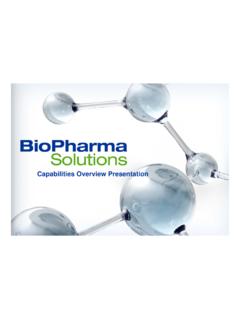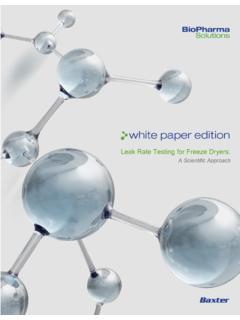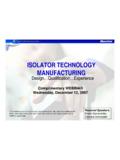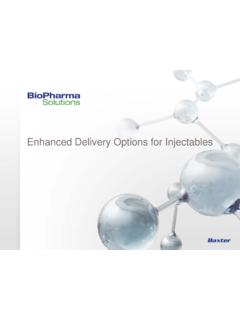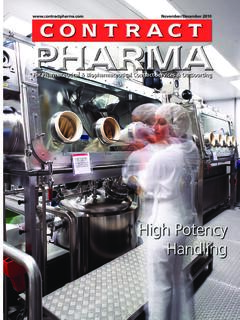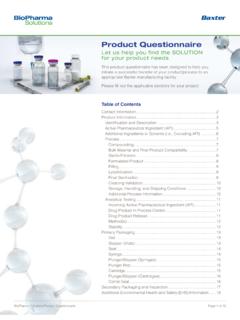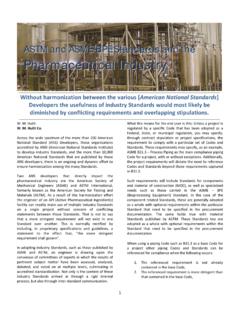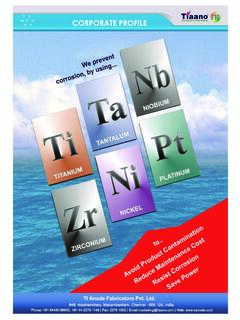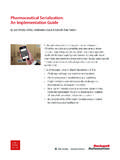Transcription of Manufacturing of Cytotoxic and Non-Cytotoxic Drugs in a ...
1 Manufacturing of Cytotoxic and Non- Cytotoxic Drugs in a Multiproduct Facility 2 Introduction When different drug products are produced in shared facilities, the potential for cross-contamination is always a concern that needs to be addressed. Drug products provide a benefit to the intended patient; however, as a cross-contaminant they can pose a risk. This is especially true when Manufacturing oncology Drugs , as many of them are highly potent substances with Cytotoxic or genotoxic effects, while others are not. In the early days of modern cancer therapy, chemotherapy with Cytotoxic small molecules was the only treatment option. The development of targeted therapies based either on small molecules or monoclonal antibodies opened ground for rapid evolution and a large diversification in the clinical landscape.
2 Especially in the field of immune-oncology, monoclonal antibodies accompanied by antibody-drug conjugates (ADCs) flourished in the pipelines of an increasing number of pharmaceutical and biotech companies. From 2015 to 2019, 57 different agents were approved for over 89 oncology indications, with some therapeutics being effective against more than one tumor type (1). Biomarker-based split up of indications adds to this complexity in cancer care and poses challenges to oncology drug manufacturers. Recent market reports suggest increasing product niches, which may lead to decreasing numbers of units per product, making dedicated facilities less practical. Outsourcing of drug product Manufacturing to a contract Manufacturing organization with experience in handling different products in shared facilities can be an option.
3 However, the experience and expertise of the CMO is crucial to avoid the risk of cross-contamination of the drug product, as failures or weaknesses in this process can pose risk to the end-user. The evolution toward a risk-based approach for cross-contamination FDA awareness of cross-contamination that can pose a serious health risk to patients was triggered mainly by two cases in the past millennium: (i) In 1998 a finished drug product, Cholestyramine Resin USP, had to be recalled because of contamination with low levels of intermediates and degradants from the production of agricultural pesticides (although no pesticides were manufactured in the finishing facility). The identified root cause was improper cleaning of storage drums in the bulk pharmaceutical suppliers factory. (ii) In 1992, a US multi-use bulk pharmaceutical manufacturer, Barr Laboratories, raised an alert.
4 The firm manufactured potent steroid products as well as non-steroidal products using common equipment with cleaning validation procedures that were regarded as inadequate (2). At that time, visibly clean as the sole acceptance criterion was challenged and made the basis for additional logically explainable criteria, the dose criterion, or the 3 or 10 ppm values (reviewed in 3). Although these dose-based values were widely accepted by the industry, none of these values made their way into official Manufacturing of Cytotoxic and Non- Cytotoxic Drugs in a Multiproduct Facility 3 regulatory guidance documents. FDA always expected a scientifically justifiable basis for the establishment of limits and that these limits are safe. By merely looking at dose-based limits, the safety aspect is not considered adequate for Drugs with a very narrow therapeutic window marked by a low therapeutic index, which is the ratio of a drug s toxic dose divided by the effective dose.
5 This development to science-based limits found its initial peak in the ISPE Risk-MaPP Baseline Guide with the definition of the Acceptable Daily Exposure (ADE) (reviewed in 4). This is a conservative approach to define a daily dose of a substance below which no adverse events are anticipated, by any route, even if exposure occurs for a lifetime (5). The EMA converted this idea into the first official guideline and established the Permitted Daily Exposure (PDE) which is effectively synonymous with the ADE (6). In practice: product separation at Baxter s Halle, Germany facility At Baxter s oncology contract Manufacturing facility in Halle, Germany, recent developments and guidance documents to help prevent cross-contamination have been fully adopted, which allow to assess risk and determine where control strategies are necessary to meet acceptable limits for cross-contamination.
6 With over 60 years of oncology experience, patient safety and world-class Manufacturing have always been (and remain) a top priority. The risk for cross-contamination is carefully assessed for each new product introduced to Baxter shared Manufacturing equipment in Halle/Germany (Figure 1). Within this risk assessment, both pharmacological/toxicological and physical properties of a drug are taken into consideration. The former is represented by a limit value ( the PDE); with the latter, API and formulation properties are judged to classify the general cleanability, the solubility of the API. Based on this risk assessment, each new product is compared to the current worst-case product established in the facility: (i) if a new product is not a worst case, it can be securely inserted into the existing product matrix; (ii) if a product is a new worst case, cleaning validation for the equipment at risk must demonstrate successful depletion of the product after Manufacturing .
7 Figure 1. Schematic drawing of the process of new product integration at Baxter s oncology facility At Baxter s oncology facility, the risk assessment is combined with state-of-the-art organizational procedures and technical standards in accordance with current industry guidance. The goal is to help ensure the greatest possible reduction of different modes of potential cross contamination whether it be (i) transfer by airborne migration of particulates, (ii) mechanical transfer from operators or equipment, (iii) residual carry-over due to inadequate cleaning, or (iv) mix-up by using wrong products, ingredients or equipment. Dedicated or single-use equipment is sometimes used to further reduce the low risk of cross-contamination within the risk-based approach. Together, this allows the handling of the following at Baxter s oncology facility: Cytotoxic and non- Cytotoxic small molecules both also in liposomal and nanoparticulate formulations monoclonal antibodies ADCs nucleic acid products, gene therapeutics 4 The risk of cross-contamination at the facility in Halle/Westfalen, Germany, is challenged in more than 30 audits per year by clients as well as thirteen different regulatory authorities.
8 Currently, four commercially approved non- Cytotoxic molecules are manufactured on multiple oncology lines, with two being manufactured for more than five years. These commercial products are successfully distributed or are planned for distribution to at least the EU and US markets. Further, ten non- Cytotoxic molecules are in transfer for commercial production on Baxter s oncology lines of which several are expected to be approved in late 2020 and 2021. Baxter Healthcare Corporation One Baxter Parkway Deerfield, Illinois, USA 60015 Email: Baxter is a registered trademark of Baxter International Inc. Any other trademarks, product brands or images appearing herein are the property of their respective owner. 920961-01 2021 Summary With the advent of more product niches and often lowered production quantities, facilities that are experienced and versatile in handling Cytotoxic , highly potent, and non- Cytotoxic oncology products can present a valid option when considering outsourcing.
9 Risks for cross-contamination must be properly assessed, using state-of-the-art organization procedures, technical standards, and current industry guidance. Ultimately, patient safety is, as always, the driving force. Literature: (1) Global Oncology Trends 2019 IQVIA Institute, May 2020 (2) Validation of cleaning processes, FDA Guide to Inspections (7/93), November 2014 (3) Cleaning Validation for the 21st Century: Acceptance Limits for Active Pharmaceutical Ingredients (APIs): Part I, Pharmaceutical Engineering, July/August 2011 (4) Cleaning Validation for the 21st Century: Acceptance Limits for Active Pharmaceutical Ingredients (APIs): Part II, Pharmaceutical Engineering, September/October 2011 (5) ISPE Baseline Pharmaceutical Engineering Guide, Vol. 7 Risk-Based Manufacture of Pharmaceutical Products, International Society for Pharmaceutical Engineering (ISPE), Second Edition, July 2017, (6) Guideline on setting health-based exposure limits for use in risk identification in the manufacture of different medicinal products in shared facilities, European Medicines Agency (EMA), EMA/CHMP/ CVMP/ SWP/169430/2012, November 2014
